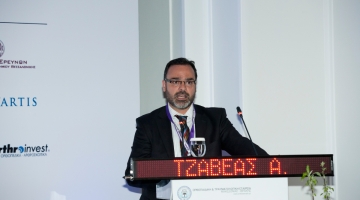Carpal Tunnel Syndrome
Carpal tunnel syndrome is a condition in which there is increased pressure on a nerve which crosses the anterior surface of the wrist (median nerve). This nerve is located in a tube, together with the tendons which bend the fingers of the hand. If this tube accept external pressure, or if the space of the tube is decreased by various causes then there is increased pressure on the nerve, which usually result in pain or numbness of the thumb, index and middle finger. These symptoms are usually worse at night. Carpal tunnel syndrome is more common in women than in men and is associated sometimes with arthritis, pregnancy, fractures of the wrist, diabetes or problems with the thyroid gland. However, for most patients, there is no particular cause for this condition.

If symptoms are mild, the disease can be treated with a special splint for the wrist used during night hours. Another therapeutic agent is the infusion (injection) of steroid drug near the carpal tunnel, which can reduce pain or numbness in most people, but the symptoms usually return in most patients after a few weeks or months. If symptoms are severe or previous therapeutic means fail, then surgical treatment is indicated.
In the event that there is a definite underlying disease causing carpal tunnel syndrome and is treated, then the symptoms disappear. But when there is no underlying cause and the disease is not treated surgically there is a risk for permanent nerve damage. This can cause atrophy of the thumb while numbness may be permanent, and in this stage surgery may not improve the symptoms.
The surgery is done in a hospital under local anesthesic. The normal duration is approximately 15 minutes. During surgery an incision is done in the palm near the wrist, which goes in depth to cut the transverse ligament which is the roof of the carpal tunnel and exerts pressure on the median nerve. The incision of this ligament eliminates the pressure on the nerve. At the end of surgery the wound closure is made with stitches, usually three to four.
After surgery the patient leaves the clinic the same day, while having his hand bandaged and on suspension. The removal of sutures is done in approximately ten days. It is important the patient to make continuously movements of the fingers from the day of surgery in order to reduce postoperative swelling.
It has been observed that in most cases (about 75% of cases) symptoms subside very fast post-operatively. In a small portion of patients symptoms are eliminated within six months.








